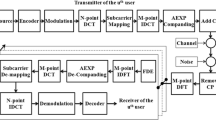Abstract
Discrete cosine transform (DCT) based single carrier frequency division multiple access (SC-FDMA) system outperforms discrete Fourier transform based SC-FDMA (DFT SC-FDMA) system in terms of bit error rate (BER) performance. However, the peak-to-average power ratio (PAPR) of the DCT SC-FDMA system is slightly higher than that of the DFT SC-FDMA system. In this paper, a companding transform is proposed by approximating the distribution of magnitudes of DCT SC-FDMA signal and thereby transforming it into a triangular distribution. Proposed companding transform effectively reduces PAPR by maintaining the average power of companded signal. By clipping the companded signal to a specific threshold, PAPR can be reduced further. Moreover, the proposed technique causes fewer spectrum side-lobes than µ law and absolute exponential companding techniques. Simulated results ensure that proposed companding followed by clipping offers better PAPR and BER performances than the absolute exponential companding technique.





















Similar content being viewed by others
References
Universal, E., Radio, T., & Ts, G. P. P. (2014). TS 136 211 - V11.5.0 - LTE; Evolved Universal Terrestrial Radio Access (E-UTRA). Physical channels and modulation (3GPP TS 36.211 version 11.5.0 Release 11), 0, 0–121. https://www.etsi.org/deliver/etsi_ts/136200_136299/136211/11.05.00_60/ts_136211v110500p.pdf.
Myung, H., Lim, J., & Goodman, D. (2006). Single carrier FDMA for uplink wireless transmission. IEEE Vehicular Technology Magazine,1(3), 30–38. https://doi.org/10.1109/MVT.2006.307304.
Mandyam, G. D. (2004). Sinusoidal transforms in OFDM systems. IEEE Transactions on Broadcasting,50(2), 172–184. https://doi.org/10.1109/TBC.2004.828375.
Al-Kamali, F. S., Dessouky, M. I., Sallam, B. M., Shawki, F., & Abd El-Samie, F. E. (2009). A new single carrier FDMA system based on the discrete cosine transform. In 2009 international conference on computer engineering and systems (pp. 555–560). IEEE. https://doi.org/10.1109/ICCES.2009.5383071.
El-Samie, F., Al-kamali, F., Al-nahari, A., & Dessouky, M. (2013). SC-FDMA for mobile communications. Boca Raton: CRC Press. https://doi.org/10.1201/b15157.
Jiang, Tao, & Yiyan, Wu. (2008). An overview: Peak-to-average power ratio reduction techniques for OFDM signals. IEEE Transactions on Broadcasting,54(2), 257–268. https://doi.org/10.1109/TBC.2008.915770.
Sezginer, S., & Sari, H. (2007). Metric-based symbol predistortion techniques for peak power reduction in OFDM systems. IEEE Transactions on Wireless Communications,6(7), 2622–2629. https://doi.org/10.1109/TWC.2007.05955.
Azurdia-Meza, C. A., Lee, K., & Lee, K. (2012). PAPR reduction in SC-FDMA by pulse shaping using parametric linear combination pulses. IEEE Communications Letters,16(12), 2008–2011. https://doi.org/10.1109/LCOMM.2012.111612.121891.
Mohammad, A., Zekry, A., & Newagy, F. (2012). A time domain SLM for PAPR reduction in SC-FDMA systems. In 2012 IEEE global high tech congress on electronics, GHTCE 2012, (1, pp. 143–147). https://doi.org/10.1109/GHTCE.2012.6490142.
Slimani, D., Khelil, A., LeBel, J., & Talbi, L. (2016). SLM localised SC-FDMA performance evaluation based on 30 GHz channel measurement for 5G. Electronics Letters,52(18), 1573–1574. https://doi.org/10.1049/el.2016.1501.
Sayed-Ahmed, A., Shokair, M., & El-Rabaie, E.-S. (2012). C42. PAPR reduction for LFDMA using a reduced complexity PTS scheme. In 2012 29th national radio science conference (NRSC) (pp. 515–522). IEEE. https://doi.org/10.1109/NRSC.2012.6208560.
Yuen, C. H. G., & Farhang-Boroujeny, B. (2012). Analysis of the optimum precoder in SC-FDMA. IEEE Transactions on Wireless Communications,11(11), 4096–4107. https://doi.org/10.1109/TWC.2012.090412.120105.
Mazahir, S., & Sheikh, S. A. (2016). On Companding Schemes for PAPR reduction in OFDM systems employing higher order QAM. IEEE Transactions on Broadcasting,62(3), 716–726. https://doi.org/10.1109/TBC.2015.2511627.
Abd El-Samie, F. E., Al-kamali, F. S., Dessouky, M. I., Sallam, B. M., & Shawki, F. (2010). Performance enhancement of SC-FDMA systems using a companding technique. Annals of Telecommunications,65(5–6), 293–300. https://doi.org/10.1007/s12243-009-0154-6.
Jiang, T., Yang, Y., & Song, Y.-H. Y. H. (2005). Exponential companding technique for PAPR reduction in OFDM systems. IEEE Transactions on Broadcasting,51(2), 244–248. https://doi.org/10.1109/TBC.2005.847626.
Hossain, M. R., & Ahmmed, K. T. (2017). Efficient PAPR reduction in DCT-SCFDMA system based on absolute exponential companding technique with pulse shaping. Wireless Personal Communications,97(3), 3449–3463. https://doi.org/10.1007/s11277-017-4678-1.
Li, Xiaodong, & Cimini, L. J. (1998). Effects of clipping and filtering on the performance of OFDM. IEEE Communications Letters,2(5), 131–133. https://doi.org/10.1109/4234.673657.
Hou, J., Ge, J., Zhai, D., Li, J., Hou, J., Ge, J., et al. (2010). Peak-to-average power ratio reduction of OFDM Signals with nonlinear companding scheme. IEEE Transactions on Broadcasting,56(2), 258–262. https://doi.org/10.1109/TBC.2010.2046970.
Hu, M., Li, Y., Liu, Y., & Zhang, H. (2014). Parameter-adjustable piecewise exponential companding scheme for peak-to-average power ratio reduction in orthogonal frequency division multiplexing systems. IET Communications,8(4), 530–536. https://doi.org/10.1049/iet-com.2013.0226.
Author information
Authors and Affiliations
Corresponding author
Additional information
Publisher's Note
Springer Nature remains neutral with regard to jurisdictional claims in published maps and institutional affiliations.
Rights and permissions
About this article
Cite this article
Kondamuri, S., Sundru, A. Non Linear Companding Transform to Mitigate PAPR in DCT Based SC-FDMA System. Wireless Pers Commun 112, 503–522 (2020). https://doi.org/10.1007/s11277-020-07057-z
Published:
Issue Date:
DOI: https://doi.org/10.1007/s11277-020-07057-z




